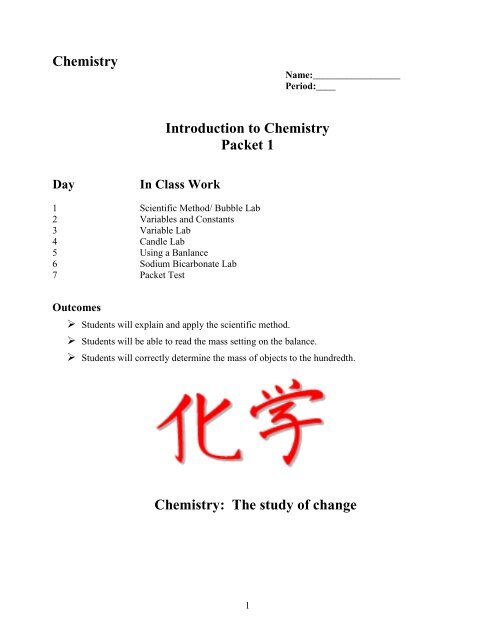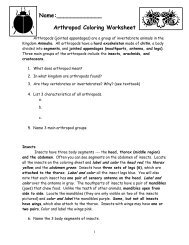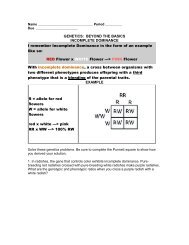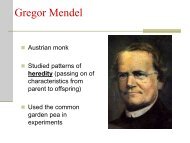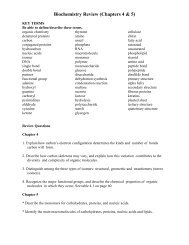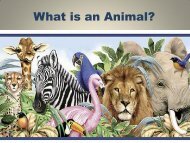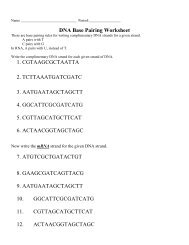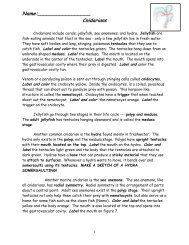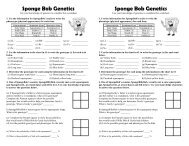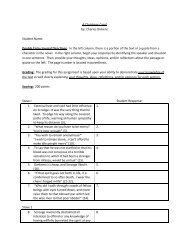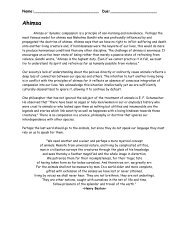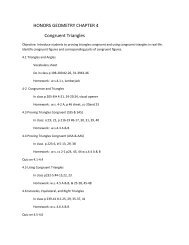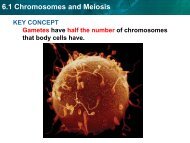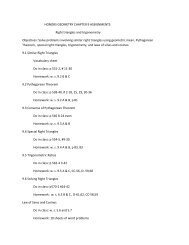Packet 1 - Holy Family Catholic Schools
Packet 1 - Holy Family Catholic Schools
Packet 1 - Holy Family Catholic Schools
Create successful ePaper yourself
Turn your PDF publications into a flip-book with our unique Google optimized e-Paper software.
Chemistry<br />
Name:__________________<br />
Period:____<br />
Introduction to Chemistry<br />
<strong>Packet</strong> 1<br />
Day<br />
In Class Work<br />
1 Scientific Method/ Bubble Lab<br />
2 Variables and Constants<br />
3 Variable Lab<br />
4 Candle Lab<br />
5 Using a Banlance<br />
6 Sodium Bicarbonate Lab<br />
7 <strong>Packet</strong> Test<br />
Outcomes<br />
‣ Students will explain and apply the scientific method.<br />
‣ Students will be able to read the mass setting on the balance.<br />
‣ Students will correctly determine the mass of objects to the hundredth.<br />
Chemistry: The study of change<br />
1
The Scientific Method<br />
A Nobel Prize winner in science once said that science is about “ordinary people doing ordinary<br />
things.” Scientists have a powerful tool that they can use to produce valuable, sometimes<br />
spectacular, results. Like all scientists, the biochemist shown in Figure 1.18 is using the scientific<br />
method to solve difficult problems. The scientific method is a logical, systematic approach to the<br />
solution of a scientific problem. Steps in the scientific method include making observations,<br />
testing hypotheses, and developing theories.<br />
Making Observations<br />
The scientific method is useful for solving many kinds of problems because it is closely related to<br />
ordinary common sense. Suppose you try to turn on a flashlight and you notice that it does not<br />
light. When you use your senses to obtain information, you make an observation. An observation<br />
can lead to a question: What’s wrong with the flashlight?<br />
Testing Hypotheses<br />
If you guess that the batteries are dead, you are making a hypothesis. A hypothesis is a proposed<br />
explanation for an observation. You can test your hypothesis by putting new batteries in the<br />
flashlight. If the flashlight lights, you can be fairly certain that your hypothesis is true. What if the<br />
flashlight does not work after you replace the batteries? A hypothesis is useful only if it accounts for<br />
what is actually observed. When experimental data does not fit a hypothesis, the hypothesis must be<br />
changed. A new hypothesis might be that the light bulb is burnt out. You can replace the bulb to test<br />
this hypothesis.<br />
Replacing the bulb is an experiment, a procedure that is used to test a hypothesis. When you design<br />
experiments, you deal with variables, or factors that can change. The variable that you change<br />
during an experiment is the manipulated variable, or independent variable. The variable that is<br />
observed during the experiment is the responding variable, or dependent variable. If you keep<br />
other factors that can affect the experiment from changing during the experiment, you can relate any<br />
change in the responding variable to changes in the manipulated variable.<br />
For the results of an experiment to be accepted, the experiment must produce the same result no<br />
matter how many times it is repeated, or by whom. This is why scientists are expected to publish a<br />
description of their procedures along with their results.<br />
Word Origins<br />
Experiment contains the Latin root peri, meaning “to try or test.” The words expert and<br />
experience contain the same root. How could experiments provide the experience for someone<br />
to become an expert.<br />
2
Bubbles!<br />
Purpose<br />
To test the hypothesis that bubble making can be affected by adding sugar or salt to a bubbleblowing<br />
mixture.<br />
Materials<br />
3 plastic drinking cups<br />
drinking straw<br />
pre-mix bubble solution<br />
Procedure<br />
1. Label three microbeakers1, 2, and 3. Fill each beaker<br />
½ full with bubble solution.<br />
2. Dip the drinking straw into cup 1, remove it, and blow<br />
gently into the straw to make the largest bubble you<br />
can. Practice making bubbles until you feel you have<br />
reasonable control over your bubble production.<br />
3. Repeat Step 3 with the mixtures in cups 2 and 3.<br />
Analyze and Conclude<br />
1. Did you observe any differences in your ability to produce bubbles using the mixtures in<br />
cup 1 and cup 2?<br />
2. Did you observe any differences in your ability to produce bubbles using the mixtures in<br />
cup 1 and cup 3?<br />
3. What can you conclude about the effects of table sugar and table salt on your ability to<br />
produce bubbles?<br />
4. Propose another hypothesis related to bubble making and design an experiment to test<br />
your hypothesis.<br />
5. Why are bubbles round?<br />
3
Developing Theories<br />
Once a hypothesis meets the test of repeated experimentation, it may be raised to a higher level of<br />
ideas. It may become a theory. A theory is a well-tested explanation for a broad set of observations.<br />
In chemistry, one theory addresses the fundamental structure of matter. This theory is very useful<br />
because it helps you form mental pictures of objects that you cannot see. Other theories allow you<br />
to predict the behavior of matter.<br />
When scientists say that a theory can never be proved, they are not saying that a theory is<br />
unreliable. They are simply leaving open the possibility that a theory may need to be changed at<br />
some point in the future to explain new observations or experimental results.<br />
Scientific Laws<br />
A scientific law is a concise statement that summarizes the results of many observations and<br />
experiments. In Chapter 14, you will study laws that describe how gases behave. One law describes<br />
the relationship between the volume of a gas in a container and its temperature. If all other variables<br />
are kept constant, the volume of the gas increases as the temperature increases. The law doesn’t try<br />
to explain the relationship it describes. That explanation requires a theory.<br />
Independent & Dependent Variables<br />
Independent Variables (IV) & Dependent Variables (DV)<br />
In an experiment, the independent variable is the variable that is varied or<br />
manipulated by the researcher, and the dependent variable is the response that is<br />
measured.<br />
An independent variable is the presumed cause, whereas the dependent variable is the presumed<br />
effect. ***The IV is the antecedent, whereas the DV is the consequent.<br />
In experiments, the IV is the variable that is controlled and manipulated by the experimenter;<br />
whereas the DV is not manipulated, instead the DV is observed or measured for variation as a<br />
presumed result of the variation in the IV.<br />
When reseaerchers are not able to actually control and manipulate an IV, it is technically referred to<br />
as a status variable (e.g., gender, ethnicity, etc.). Even though researchers do not actually control or<br />
manipulate status variables, researchers can, and often do, treatthem as IVs (Heppner, Kivlighan &<br />
Wampold, 1999).<br />
"The DV refers to the status of the 'effect'(or outcome) in which the researcher is interested; the<br />
independent variable refers to the status of the presumed 'cause,' changes in which lead to changes<br />
in the status of the dependent variable…any event or condition can be conceptualized as either an<br />
independent or a dependent variable. For example, it has been observed that rumor-mongering can<br />
sometimes cause a riot to erupt, but it has also been observed that riots can cause rumors to surface.<br />
4
Rumors are variables that can be conceived of as causes (IVs) and as effects (DVs)." (Rosenthal &<br />
Rosnow, 1991, p. 71)<br />
Some Examples of Independent and Dependent Variables<br />
1. "There will be a statistically significant difference in graduation rates of at-risk high-school<br />
seniors who participate in an intensive study program as opposed to at-risk high-school seniors who<br />
do not participate in the intensive study program." (LaFountain & Bartos, 2002, p. 57)<br />
IV: Participation in intensive study program. DV: Graduation rates.<br />
List the Independent and Dependent Variables for the following:<br />
If one were to measure the influence of different quantities of fertilizer on plant growth, the<br />
independent variable would be the __________________ used (the changing factor of the<br />
experiment). The dependent variables would be the ________________ of the plant (the factors<br />
that are influenced in the experiment) and the controlled variables would be the<br />
_____________________________________________________________________________<br />
_____________________________________________________________________________<br />
In a study of how different doses of a drug affect the severity of symptoms, a researcher could<br />
compare the frequency and intensity of symptoms (_______________ variables) when different<br />
doses (_______________ variable) are administered, and attempt to draw a conclusion. The<br />
controlled variables would be the<br />
_____________________________________________________________________________<br />
In measuring the acceleration of a vehicle, time is usually the ___________ variable and speed<br />
is the ____________ variable. This is because when taking measurements, times are usually<br />
predetermined, and the resulting speed of the vehicle is recorded at those times. The controlled<br />
variables would be the<br />
_____________________________________________________________________________<br />
In measuring the amount of color removed from beetroot samples at different temperatures, the<br />
dependent variable would be the_________________, because it is depending on the<br />
_______________ (which is the independent variable). The controlled variables would be the<br />
_____________________________________________________________________________<br />
In sociology, in measuring the effect of education on income or wealth, the dependent variable<br />
could be a _____________________ measured in monetary units (United States Dollars for<br />
example), and an independent variable could be the ________________of the individual(s) who<br />
compose(s) the household (i.e. academic degrees). The controlled variables would be the<br />
_____________________________________________________________________________<br />
5
Variables and Constants<br />
Many experiments are designed to determine the relationship between the independent and<br />
dependent variable. The other variables which could interfere with the experiment must be held<br />
constant.<br />
In this experiment we will investigate if the time need to heat water to 80° C is affected by its<br />
distance from Bunsen burner. The independent variable is ____________________________ and<br />
the dependent variable is _____________________________.<br />
In order to find the relationship between these two variables, other variables which could interfere<br />
with the investigation must be held constant. Some possible constants for this experiment are<br />
________________________________________________________________________________<br />
________________________________________________________________________________<br />
________________________________________________________________________________<br />
Write a procedure to solve the problem we are investigating. A procedure is a series of steps to<br />
follow to perform the lab. These steps are written to control each of the constants. Each numbered<br />
step should contain only one idea.<br />
Procedure<br />
Data:<br />
Conclusion:<br />
How could this lab be improved?<br />
6
Candle Lab<br />
Problem: What products form in the chemical reaction of a burning-candle?<br />
Make observations about candles?<br />
Hypothesis-<br />
Experiment<br />
1. Place a drop of tap water on a piece of cobalt chloride test paper, and indicator, and note the color change<br />
caused by water. What does cobalt chloride paper indicate? _________________<br />
2. Light the candle and invert a 400ml beaker over the flame until it goes out. Test any liquid formed in the<br />
beaker with the cobalt chloride test paper.<br />
3. Is this evidence for water being a product and explain.<br />
4. Obtain a 50-ml Erlenmeyer flask and fill it half full with limewater, an indicator. The lime water is<br />
dispensed by gravity so just pinch the stopcock.<br />
5. Measure 10 ml of lime water into the flask. Exhale through a straw into the lime water until a change<br />
occurs. What does limewater indicate? ____________<br />
6. Obtain a 50-ml Erlenmeyer flask, relight the candle, and invert the flask over the burning candle until the<br />
flame goes out. Remove the flask and quickly place it upright. Add about 10 ml of limewater solution to the<br />
flask, seal it a glass plate, swirl the solution, and watch for changes in the solution. Carbon dioxide gas<br />
causes limewater to turn cloudy.<br />
7. Decide if this is evidence for carbon dioxide being a product and explain.<br />
8. Make a data table with two columns, one for time and one for temperature.<br />
9. Obtain a large test tube, test tube holder and thermometer. Half fill the test tube with tap water. Measure<br />
and record the temperature of the water; record this first time entry as zero. Keep the thermometer in the<br />
middle of the water and away from the sides and bottom of the test tube. Hold the test tube just above the<br />
candle flame, heat the water and record the temperature every 30 seconds for two minutes. This will give<br />
you five temperatures to record.<br />
7
10. Plot a temperature-time graph with time as the independent variable and temperature as the dependent<br />
variable.<br />
11. Decide if heat is a product and explain.<br />
12. Write a conclusion.<br />
8
Scientific Method<br />
A marine biologist conducted a study of the ability of vertebrate blood to carry oxygen. He believed that a low<br />
environmental temperature would cause the organism's blood to carry less oxygen than blood at a higher<br />
temperature. The following reflects the scientists experiment and the data he collected.<br />
Two tanks of salt water, each containing 25 gallons, was set up in the lab.<br />
Each tank was filled with the same types of organisms ( perch and salmon ).<br />
The same type of aerators were added to each tank to supply dissolved oxygen to the fish.<br />
To one of the tanks, marked TANK A, the temperature was decreased at increments of 5 degrees C<br />
every 20 minutes.<br />
The second tank, marked TANK B, the temperature is raised at increments of 5 degrees C every 20<br />
minutes.<br />
Blood was removed from each of the fish and measured for its oxygen content.<br />
Below is the results from the above experiment.<br />
Temperature in<br />
Degrees C<br />
Amount of Dissolved Oxygen<br />
found in fish in Tank A -ml/g<br />
Temperature in<br />
Degrees C<br />
Amount of Dissolved Oxygen<br />
found in fish in Tank B -ml/g<br />
25 35 25 35<br />
20 30 30 32<br />
15 23 35 39<br />
10 12 40 35<br />
5 8 45 20<br />
1. What is the hypothesis of the above experiment?<br />
_____________________________________________________________________________<br />
2. Is the above experiment a controlled experiment?<br />
_____________________________________________________________________________<br />
3. Explain your answer to question 2.<br />
_____________________________________________________________________________<br />
_____________________________________________________________________________<br />
_____________________________________________________________________________<br />
4. What term would be used to denote a person who studies blood?<br />
_____________________________________________________________________________<br />
5. What is the variable factor in the above experiment?<br />
_____________________________________________________________________________<br />
9
Line Graph the above data and then answer the questions that follow.<br />
TITLE: _____________________________________________________________________<br />
6. What is the dependent variable?<br />
____________________________________________________________________________<br />
7. What is the independent variable?<br />
____________________________________________________________________________<br />
8. Based on the above data, is the scientists hypothesis correct?<br />
____________________________________________________________________________<br />
9. What are the controls used in the above<br />
experiment?__________________________________________________________________<br />
_____________________________________________________________________________<br />
_____________________________________________________________________________<br />
10
<strong>Packet</strong> 1 Scientific Method<br />
1. Why should a hypothesis be developed before experiments take place?<br />
2. Why is it important for scientists to publish a description of their procedures along with the<br />
results of their experiments?<br />
3. What is the difference between a theory and a scientific law?<br />
4. If your heart beats at an average rate of 72 times per minute, how many times will your heart<br />
beat in an hour? In a day?<br />
5. How many days would it take you to count a million pennies if you could count one penny each<br />
second?<br />
6. Describe a situation in which you used at least two steps in the scientific method to<br />
solve a problem.<br />
7. Pure water freezes at 0°C. A student wanted to test the effect of adding salt to the water. The<br />
table shows the data that was collected.<br />
a. What was the manipulated/independent<br />
variable?<br />
b. What was the responding/dependent<br />
variable?<br />
c. Why must the volume of water be the<br />
same for each test?<br />
d. Based on the data, the student hypothesized, “As more salt is added to water, the<br />
temperature of the water decreases.” Is this hypothesis supported by the data? Explain.<br />
Use this paragraph to answer Questions 8–10.<br />
(1) On a cold morning, your car does not start. (2) You say, “Oh no! The battery is dead!”. (3) Your<br />
friend who works on cars uses a battery tester and finds that the battery has a full charge. (4) Your<br />
friend notices a lot of corrosion on the battery terminals. (5) Your friend says, “Maybe corrosion is<br />
causing a bad connection in the electrical circuit, preventing the car from starting.” (6) Your friend<br />
cleans the terminals and the car starts.<br />
8. Which statements are observations?<br />
9. Which statements are hypotheses?<br />
10. Which statement describes an experiment?<br />
11


